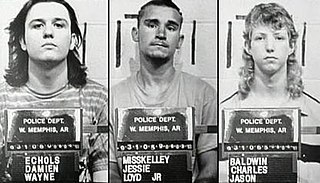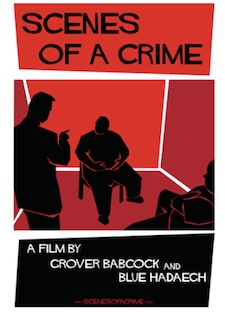Related Research Articles

The West Memphis Three are three men convicted as teenagers in 1994 of the 1993 murders of three boys in West Memphis, Arkansas, United States. Damien Echols was sentenced to death, Jessie Misskelley Jr. to life imprisonment plus two 20-year sentences, and Jason Baldwin to life imprisonment. During the trial, the prosecution asserted that the juveniles killed the children as part of a Satanic ritual.
The Central Park jogger case was a criminal case concerning the assault and rape of Trisha Meili, a white woman in Central Park in Manhattan, New York, on April 19, 1989. On the night of the attack, a group of around 30 teenagers had entered the park; some members of the group committed a string of other attacks. Five black and Latino youths were convicted of assaulting the woman, and served sentences ranging from six to twelve years. All later had their charges vacated after a prison inmate, serial rapist Matias Reyes confessed to the crime and DNA evidence confirmed his involvement.

Etan Kalil Patz was an American boy who was six years old on May 25, 1979, when he disappeared on his way to his school bus stop in the SoHo neighborhood of Lower Manhattan. His disappearance helped launch the missing children movement, which included new legislation and new methods for tracking down missing children. Several years after he disappeared, Patz was one of the first children to be profiled on the "photo on a milk carton" campaigns of the early 1980s. In 1983, President Ronald Reagan designated May 25—the anniversary of Etan's disappearance—as National Missing Children's Day in the United States.
Nicholas John 'Nick' Baker is a British citizen who was convicted of smuggling cocaine and ecstasy into Japan. He was arrested at Narita Airport on 13 April 2002 and found guilty by the Chiba Prefecture District Court in June 2003. He was sentenced to 14 years' jail with forced labour and fined ¥5,000,000. At his trial Baker claimed that he was tricked by his travelling companion, James Prunier, into carrying the drugs through customs in a false-bottomed suitcase. Baker also claimed that during his initial detention he was mistreated by Japanese authorities with sleep deprivation, no access to legal counsel, and that he was forced to sign a confession written in poor and inaccurate English. Baker's conviction was upheld on appeal but Baker's sentence was reduced to 11 years in prison and the fine to ¥3,000,000. Baker was transferred back to England in the Spring of 2008 to serve the remainder of his sentence. After spending six-months at London's Wandsworth prison, Baker was released on licence in October 2008.

Within the criminal justice system of Japan, there exist three basic features that characterize its operations. First, the institutions—police, government prosecutors' offices, courts, and correctional organs—maintain close and cooperative relations with each other, consulting frequently on how best to accomplish the shared goals of limiting and controlling crime. Second, citizens are encouraged to assist in maintaining public order, and they participate extensively in crime prevention campaigns, apprehension of suspects, and offender rehabilitation programs. Finally, officials who administer criminal justice are allowed considerable discretion in dealing with offenders.
A false confession is an admission of guilt for a crime which the individual did not commit. Although such confessions seem counterintuitive, they can be made voluntarily, perhaps to protect a third party, or induced through coercive interrogation techniques. When some degree of coercion is involved, studies have found that subjects with highly sophisticated intelligence or manipulated by their so called "friends" are more likely to make such confessions. Young people are particularly vulnerable to confessing, especially when stressed, tired, or traumatized, and have a significantly higher rate of false confessions than adults. Hundreds of innocent people have been convicted, imprisoned, and sometimes sentenced to death after confessing to crimes they did not commit—but years later, have been exonerated. It was not until several shocking false confession cases were publicized in the late 1980s, combined with the introduction of DNA evidence, that the extent of wrongful convictions began to emerge—and how often false confessions played a role in these.
Richard Jason Ofshe is an American sociologist and professor emeritus of sociology at the University of California, Berkeley. He is known for his expert testimony relating to coercion in small groups, confessions, and interrogations.
Nelson Hart was a Gander, Newfoundland and Labrador, Canada, resident, who was convicted on March 28, 2007, of murdering his three-year-old twin daughters in 2002. He successfully appealed the conviction in 2007, and his 2014 confession to police, obtained through a Mr. Big Sting operation, was found to be inadmissible. Without the confession, Newfoundland and Labrador prosecutors declined to pursue a new trial.

Channon Gail Christian, aged 21, and Hugh Christopher Newsom Jr., aged 23, were from Knoxville, Tennessee, United States. They were kidnapped on the evening of January 6, 2007, when Christian's vehicle was carjacked. The couple were taken to a rental house. Both of them were raped, tortured, and murdered. Four males and one female were arrested, charged, and convicted in the case. In 2007, a grand jury indicted Letalvis Darnell Cobbins, Lemaricus Devall Davidson, George Geovonni Thomas, and Vanessa Lynn Coleman on counts of kidnapping, robbery, rape, and murder. Also in 2007, Eric DeWayne Boyd was indicted by a federal grand jury of being an accessory to a carjacking, resulting in serious bodily injury to another person, and misprision of a felony. In 2018, Boyd was indicted on state-level charges of kidnapping, robbery, rape, and murder.
The murder of 12-year-old Stephanie Crowe took place in her bedroom inside her home at Escondido, California, sometime between late night January 20, 1998, to early morning January 21, 1998. Stephanie's parents and grandmother found her body on the floor of her bedroom on the morning of January 21, 1998. She had been stabbed eight times. There was no sign of forced entry. Stephanie's window was found unlocked, but a screen was in place and there was no disturbance of accumulated grime and insect traces. A sliding glass door in her parents' bedroom was also unlocked. No knives were found at the scene that seemed consistent with the murder weapon, and no bloody clothing was found despite an exhaustive search.
Michael Mark Welner, M.D., is an American forensic psychiatrist and Chairman of The Forensic Panel. Welner is best known for his work in sensitive and complex litigation. He has acted as lead forensic psychiatric examiner in numerous criminal or court proceedings of national and international prominence, including precedent-setting trials and higher court decisions. Welner is also known for a number of innovations in forensic science, forensic psychiatry and justice, including protocols for prospective peer review in forensic medicine consultation, research to standardize an evidence-based distinction of the worst crimes, The Depravity Standard, and recommendations for upgrading forensic science assessment. He has been featured in network television news coverage of forensic psychiatry issues, has authored publications for professional and public audiences, and has contributed to emerging legislation on mental health reform.
The Norfolk Four are four former United States Navy sailors: Joseph J. Dick Jr., Derek Tice, Danial Williams, and Eric C. Wilson, who were wrongfully convicted of the 1997 rape and murder of Michelle Moore-Bosko while they were stationed at Naval Station Norfolk. They each declared that they had made false confessions, and their convictions are considered highly controversial. A fifth man, Omar Ballard, confessed and pleaded guilty to the crime in 2000, insisting that he had acted alone. He had been in prison since 1998 because of violent attacks on two other women in 1997. He was the only one of the suspects whose DNA matched that collected at the crime scene, and whose confession was consistent with other forensic evidence.

Jon Graham Burge was an American police detective and commander in the Chicago Police Department who was found guilty of having "directly participated in or implicitly approved the torture" of at least 118 people in police custody in order to force false confessions.
Saul Kassin is a distinguished professor of psychology at John Jay College of Criminal Justice - City University of New York and Massachusetts Professor Emeritus of Psychology at Williams College in Williamstown, Massachusetts.

Caylee Marie Anthony was an American girl who lived in Orlando, Florida, with her mother, Casey Marie Anthony, and her maternal grandparents, George and Cindy Anthony. On July 15, 2008, she was reported missing in a 9-1-1 call made by Cindy, who said she had not seen Caylee for 31 days and that Casey's car smelled like a dead body had been inside it. Cindy said Casey had given varied explanations as to Caylee's whereabouts before finally telling her that she had not seen Caylee for weeks. Casey lied to detectives, telling them Caylee had been kidnapped by a nanny on June 9, and that she had been trying to find her, too frightened to alert the authorities. She was charged with first-degree murder in October 2008 and pled not guilty.

The Brenton Butler case was a murder case in Jacksonville, Florida. During the investigation of a shooting death outside a motel in 2000, police arrested 15-year-old Brenton Butler and charged him with the murder. Butler subsequently confessed to the crime, and the case went to trial. However, during the trial he testified that he had been brutalized into his confession, and he was acquitted. The case gained significant notice in the media, and became the subject of an award-winning documentary, Murder on a Sunday Morning.

On July 23, 2007, Linda Hayes and Joshua Komisarjevsky invaded the residence of the Petit family in Cheshire, Connecticut. Though initially planning only to rob the house, she and Komisarjevsky murdered Jennifer Hawke-Petit and her two daughters, 17-year-old Hayley Petit and 11-year-old Michaela Petit. Their father Dr. William Petit escaped with severe injuries.

Scenes of a Crime is a documentary film that focuses on the case of Adrian P. Thomas who was the subject of nearly 10 hours of interrogation by Troy, New York police, culminating in a controversial confession and high profile murder trial. The film won multiple festival awards, a Gotham Award for "Best Film Not Playing At Theater Near You," played theatrically and was broadcast nationally. Reviews of the film were highly favorable.
Daniel Ken Holtzclaw is a former police officer in the United States. He was convicted in December 2015 of multiple counts of rape, sexual battery, forcible oral sodomy, and other sexual charges while working for the Oklahoma City Police Department.
Brendan Ray Dassey is an American convicted murderer from Manitowoc County, Wisconsin, who at 16 confessed to being a party to first-degree murder, mutilation of a corpse, and second-degree sexual assault. He was sentenced to life in prison with the earliest possibility of parole in 2048. His videotaped interrogation and confession, which he recanted at trial, substantially contributed to his conviction. Parts were shown in the Netflix documentary series Making a Murderer (2015). The series examined the 2005–2007 investigation, prosecution, and trials of Dassey and his uncle, Steven Avery, both of whom were convicted of murdering the photographer Teresa Halbach on October 31, 2005.
References
- 1 2 3 4 5 6 7 8 9 Holden, Stephen (March 29, 2012). "A Death, a Conviction, and a Disputed Confession". The New York Times . Archived from the original on June 18, 2014. Retrieved June 18, 2014.
- 1 2 3 Roberts, Luke (June 13, 2014). "Former Douglas Man 'Not Guilty' On Murder Charges In New York". The Douglas Enterprise. Archived from the original on June 18, 2014. Retrieved June 18, 2014.
- 1 2 Crowe II, Kenneth C. (November 13, 2009). "Troy father learns fate for killing: Adrian Thomas gets 25 years to life in the death of his infant son". Times Union . Archived from the original on July 14, 2014. Retrieved June 18, 2014.
- 1 2 3 4 5 6 7 Martin, Michel (November 14, 2011). "'Scenes Of A Crime' Probes Police Interrogations". NPR. Archived from the original on July 14, 2014. Retrieved June 18, 2014.
- ↑ Eadie, Molly (June 6, 2014). "Neuropathologist's opinion is that Matthew Thomas died of bacterial sepsis". The Record . Retrieved June 18, 2014.
- 1 2 3 Gardinier, Bob (November 10, 2009). "A defendant's words, on video". Times Union . Archived from the original on July 14, 2014. Retrieved June 18, 2014.
- ↑ Gardinier, Bob. "Video: They were all lies". Times Union . Archived from the original on July 14, 2014. Retrieved June 18, 2014.
- ↑ Gardinier, Bob (October 20, 2008). "Witness: Dad's confession in slaying coerced". Times Union . Archived from the original on July 14, 2014. Retrieved June 18, 2014.
- ↑ Canfield, Dave (October 21, 2009). "Closing arguments to begin". The Record . Retrieved June 18, 2014.
- 1 2 3 4 Martin, Michel (June 17, 2014). "Man Freed After Confessing To Killing Son During Interrogation". NPR. Archived from the original on June 18, 2014. Retrieved June 18, 2014.
- ↑ Turan, Kenneth (April 12, 2012). "Movie review: 'Scenes of a Crime'". Los Angeles Times . Archived from the original on July 15, 2014. Retrieved June 18, 2014.
- ↑ Kaufman, Anthony (March 26, 2012). ""Scenes of a Crime": Unjust Verdict Upheld as Doc Winner Hits Theaters". Indiewire. Archived from the original on July 14, 2014. Retrieved June 18, 2014.
- 1 2 Gardineir, Bob (March 22, 2012). "Appeal denied in slaying of son". Times Union . Archived from the original on July 14, 2014. Retrieved June 18, 2014.
- ↑ McKinley, James C. Jr. (February 20, 2014). "Police Coercion Cited in Order for Retrial in Upstate New York Killing". The New York Times . Archived from the original on March 3, 2014. Retrieved June 18, 2014.
- ↑ Gardinier, Bob (May 27, 2014). "A child's death: Retrial begins Tuesday". Times Union . Archived from the original on July 14, 2014. Retrieved June 19, 2014.
- ↑ Gardinier, Bob (June 11, 2014). "Jury to weigh in on Adrian Thomas infanticide retrial". Times Union . Archived from the original on July 14, 2014. Retrieved June 18, 2014.
- ↑ Gardinier, Bob (June 9, 2014). "No testimony Monday in Adrian Thomas trial". Times Union . Archived from the original on July 14, 2014. Retrieved June 18, 2014.
- ↑ Eadie, Molly (June 12, 2014). "Jury begins to deliberate Adrian Thomas' fate". The Record . Retrieved June 18, 2014.
- 1 2 3 Gardinier, Bob (June 12, 2014). "Stunning 'not guilty': Adrian Thomas acquitted of killing infant son six years ago at second trial". Times Union . Archived from the original on June 15, 2014. Retrieved June 18, 2014.
- ↑ Staff (June 12, 2014). "Not guilty verdict leaves Adrian Thomas surprised". Fox 23 News. Archived from the original on July 14, 2014. Retrieved June 18, 2014.
- ↑ The Associated Press (June 13, 2014). "Adrian Thomas, New York father, acquitted of killing infant son". Newsday. Archived from the original on June 16, 2014. Retrieved June 18, 2014.
- 1 2 Felsenstein, Sara (June 25, 2014). ""Scenes of a Crime" subject Adrian Thomas found not guilty in retrial". MSNBC. Archived from the original on July 14, 2014. Retrieved June 27, 2014.
- 1 2 Gallini, Brian (September 17, 2009). "Police 'Science' in the Interrogation Room: Seventy Years of Pseudo-Psychological Interrogation Methods to Obtain Inadmissible Confessions". Hastings Law Journal, Vol. 61. SSRN 1474813.
- ↑ Staff (June 13, 2014). "How Far is Too Far in the Interrogation Room?". WRGB. Archived from the original on June 25, 2014. Retrieved June 18, 2014.